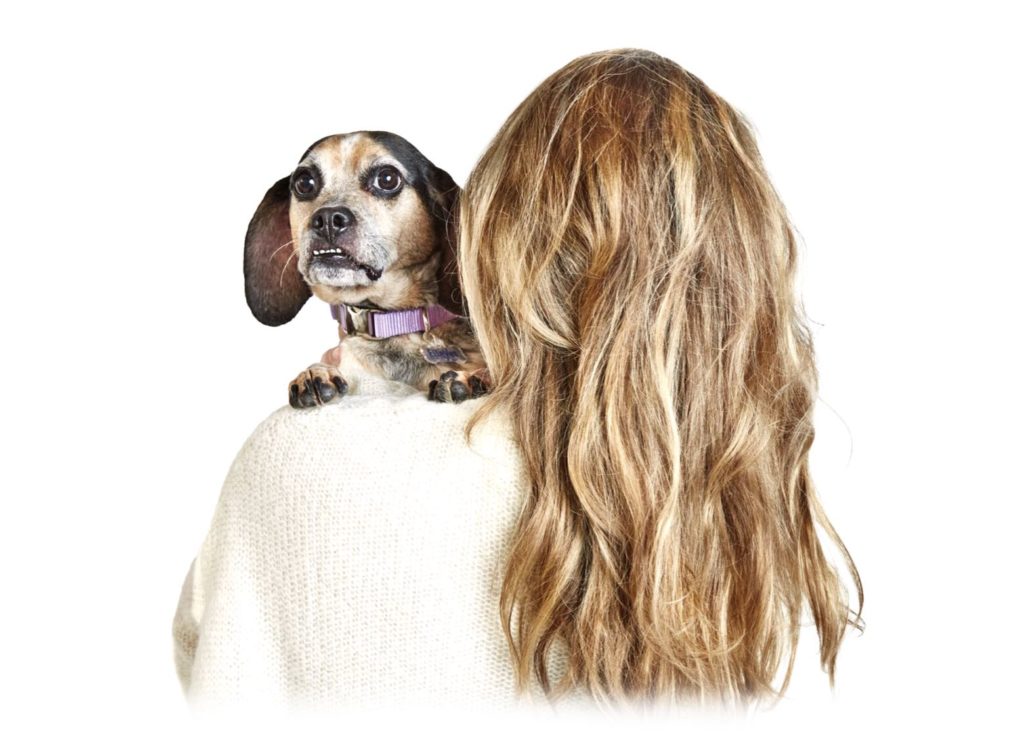So, you suspect your pup may be losing their hearing or maybe believe that they were born deaf. How did this happen? The most likely cause is a natural result of aging, but there are some other factors at play regarding your dog’s auditory modality.
There is good news – your dog can still enjoy an excellent quality of life! Here is a guide to understanding your pup’s hearing loss and four ways to support your dog and improve both your qualities of life.
Is My Dog Deaf?
Okay, so you know how a dog can lose their hearing – but how do you know if your dog is deaf? Puppies who are deaf may seem slow to learn. Pet parents may notice these signs as an older dog gradually loses hearing:
- Not coming when called: unresponsiveness is a key indicator of a pet’s hearing loss. To test your pup’s hearing abilities, make various noises when they aren’t looking, such as jingling keys or clapping. You will be able to gauge their hearing abilities by their response to the auditory stimuli.
- Sudden disobedience: sometimes, we confuse gradual-onset hearing loss with a behavioral problem. Dogs may stop responding to commands or require more focus to bring to attention.
- Increased startle reflex: Other senses heighten as hearing diminishes. Therefore, a hearing-impaired dog will have a heightened sense of touch. Without the auditory cues, stimuli are both surprising and may seem overwhelming. A dog who appears to startle more may be suffering hearing loss.
- Excessive barking: Animals regulate their voices using their sense of hearing. If this diminishes, they may not know how loud they are being. Barking is a natural response as they navigate their new methods of communication.
If you want to know for sure whether your pup is hearing impaired, visit your veterinarian. Objective assessment of auditory function’s presence requires a test known as the BAER (brainstem auditory evoked response).
How Did My Dog Lose Their Hearing?
Dog hearing loss occurs like human hearing loss. Three pairs of descriptors characterize hearing loss: inherited or acquired, congenital or later-onset, and sensorineural or conductive. Conductive hearing loss occurs when sound conduction is impeded through the external ear, the middle ear, or both. Sensorineural hearing loss occurs when there is a problem with the cochlea or the neural pathway to the auditory cortex. The most frequently observed forms of hearing loss are:
- Acquired later-onset sensorineural deafness can be the result of exposure to medicine or noise, which damages the inner ear, in addition to aging. The most common form of this type of hearing loss is called presbycusis, or aging-related hearing loss (ARHL)
- Inherited congenital sensorineural deafness is usually associated with pigmentation genes responsible for white in the coat. This means that a dog is born with a condition with a problem in the cochlea or the neural pathway to the auditory cortex.
- Acquired conductive hearing loss occurs when sound conduction is impeded through the outer ear; common reasons for conductive hearing loss include blockage of an ear canal, a hole in an eardrum, or problems with the bones in the ear. If you see signs of redness or inflammation deep in the ear, share with your veterinarian, as they can resolve these problems with proper treatment.
The most common form of hearing loss in dogs is acquired later-onset sensorineural deafness, specifically age-related hearing loss (ARHL).
How Did My Dog “Acquire” Sensorineural Deafness?
It is widespread for senior dogs to gradually lose their hearing – with geriatric nerve degeneration in the cochlea beginning as young as 7-8 years of age. Some hearing loss is natural, as it inevitably happens to all mammals, but it can be accelerated if they live in louder environments. It has been estimated that above 85 decibels, a dog’s inner ear is at risk for damage. Here are decibels of everyday sounds:
- Whisper: 30
- Normal Talking: 40
- Dishwasher, Microwave: 60
- Blow Dryer: 70
- City Traffic: 70
- Vacuum Cleaner: 80
- Lawn Mower: 90
- Screaming Child: 90
- Power Drill: 110
- Ambulance: 130
- Gunshot: 130
- Fire Engine Siren: 140
Age-related hearing loss (ARHL, also called: presbycusis) is the most common form of hearing loss and begins by impairing perception of middle to high-frequency sounds but encompasses the entire range of sound frequencies as it progresses. Audiograms of dogs in a longitudinal study (a study that involves looking at variables over an extended time) reveal a progressive increase in hearing thresholds (the lowest level sound that can be heard 50% of the time, measured in decibels) with aging, starting at 8-10 year. The effect is most pronounced at the middle to high frequencies.
Four Ways to Support Your Deaf Dog
Unfortunately, there are no standard strategies that restore hearing in dogs with ARHL. A 2010 study reported on three Beagles with ARHL who received ear implants; the results were equivocal. Additionally, hearing aids have been tried, but they are not suitable for every dog.
So, while watching your beloved family member lose their hearing can evoke sadness and frustration, The quality of life of deaf dogs is not demonstrably diminished – and the brain responds to the loss of a sensory modality by various forms of plasticity. Deaf dogs do not self-pity, and they can pick up on our emotions and moods. So, there is a chance, if we pity them, they think they did something wrong to make us feel bad.
Here are four tips to make a positive difference in the lives of both you and your pup.
- Check-in with Your Vet: Make sure that your dog’s hearing loss is ARHL. Inflammation or infection will compound with any age-related hearing loss your pup suffers – so, getting any secondary issues appropriately treated is essential. Additionally, your vet will likely have advice for you further to provide your dog with a good quality of life.
- Use Signals: Dogs have a history of responding well to hand signs and cues, and it may not be as hard as you believe to teach a dog American Sign Language (ASL). ASL is the most commonly used sign, but any method of signing will be effective. K9Sign is an example of a hand-sign language explicitly developed; if for communication with dogs. Even if your pup is not hearing-impaired, it can be helpful to teach them signs when they are young – this is not to say, however, that your old dog can’t learn new tricks (they can!)
- Avoid Surprises: With a decrease in sensory modality, your pup’s other senses will heighten. This means that they may be easier to startle. Additionally, they can’t hear you coming! So, approach your dog in their field of vision and gently touch your pup in the same place: the shoulder area is ideal.
- Hearing Aids: Attempts have been made to develop hearing aids for dogs; however, they are rare and do not restore hearing to its former level or its original quality. Additionally, getting a dog to wear hearing aids and then teaching him to interpret the sounds and relearn their meanings requires a great deal of training. While it is possible to fit your pup for hearing aids, they do not “suffer” from hearing loss as humans may, and a dog can enjoy a happy life – even with diminished hearing.
- Be Aware: Increase your vigilance with a deaf dog. This means fencing in your yard and keeping them on a leash, especially around cars. It is also helpful to attach an “I am deaf” tag to your dog’s collar if they are lost.
Overall, it can be challenging to face the reality of a beloved dog losing their hearing. It is easy to feel frustration, sadness, and impatience with your older dog. But, with patience and compassion, your relationship with your dog will grow as your hearing-impaired dog remained very capable of enjoying an excellent quality of life.
The ElleVet Team
844-673-7287
[email protected]
-
 ElleVet Hemp CBD + CBDA Soft Chews$89.00 – $99.00 — or subscribe and save 15%
ElleVet Hemp CBD + CBDA Soft Chews$89.00 – $99.00 — or subscribe and save 15% -
 ElleVet Hemp CBD + CBDA Soft Gels$49.00 – $159.00 — or subscribe and save 15%
ElleVet Hemp CBD + CBDA Soft Gels$49.00 – $159.00 — or subscribe and save 15% -
 ElleVet Hemp CBD + CBDA Oil For Dogs$79.00 – $249.00 — or subscribe and save 15%
ElleVet Hemp CBD + CBDA Oil For Dogs$79.00 – $249.00 — or subscribe and save 15%









